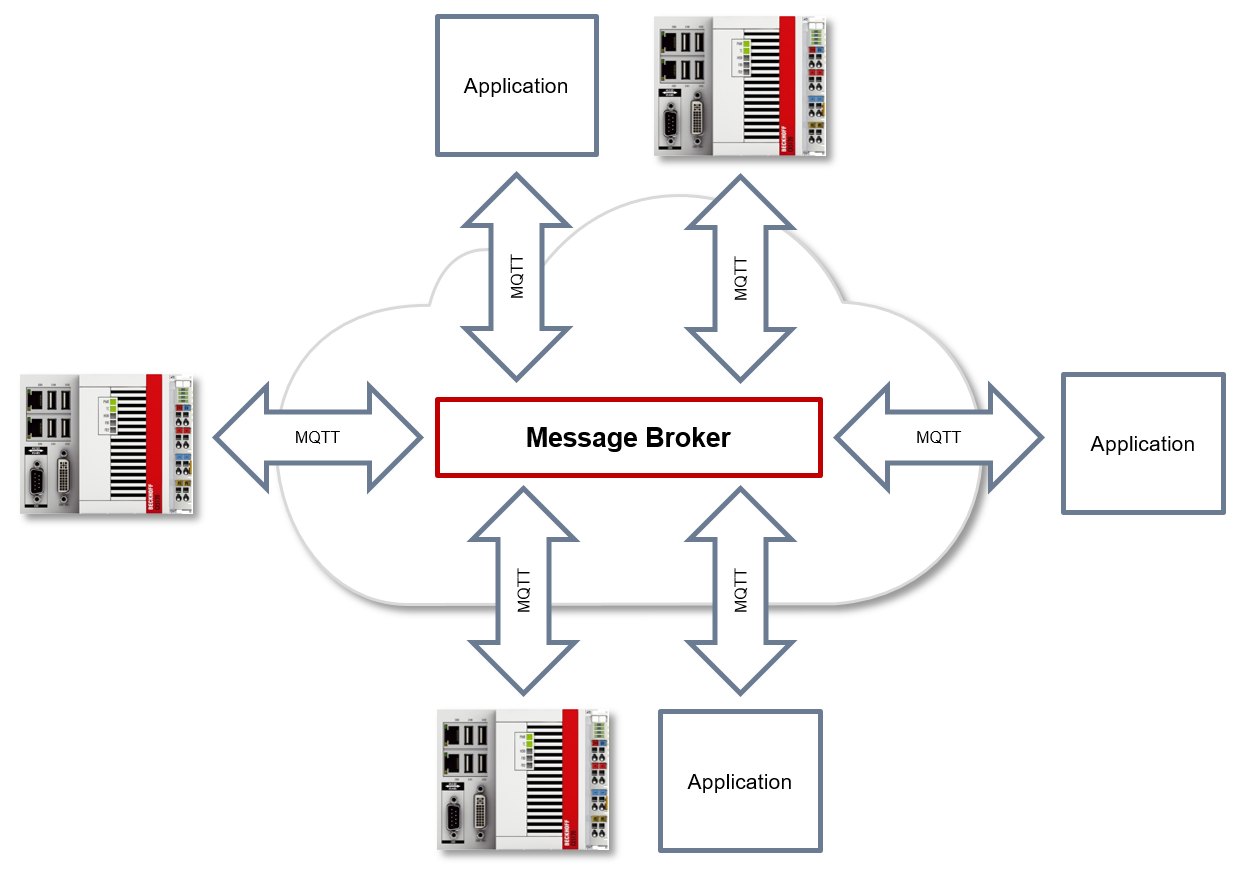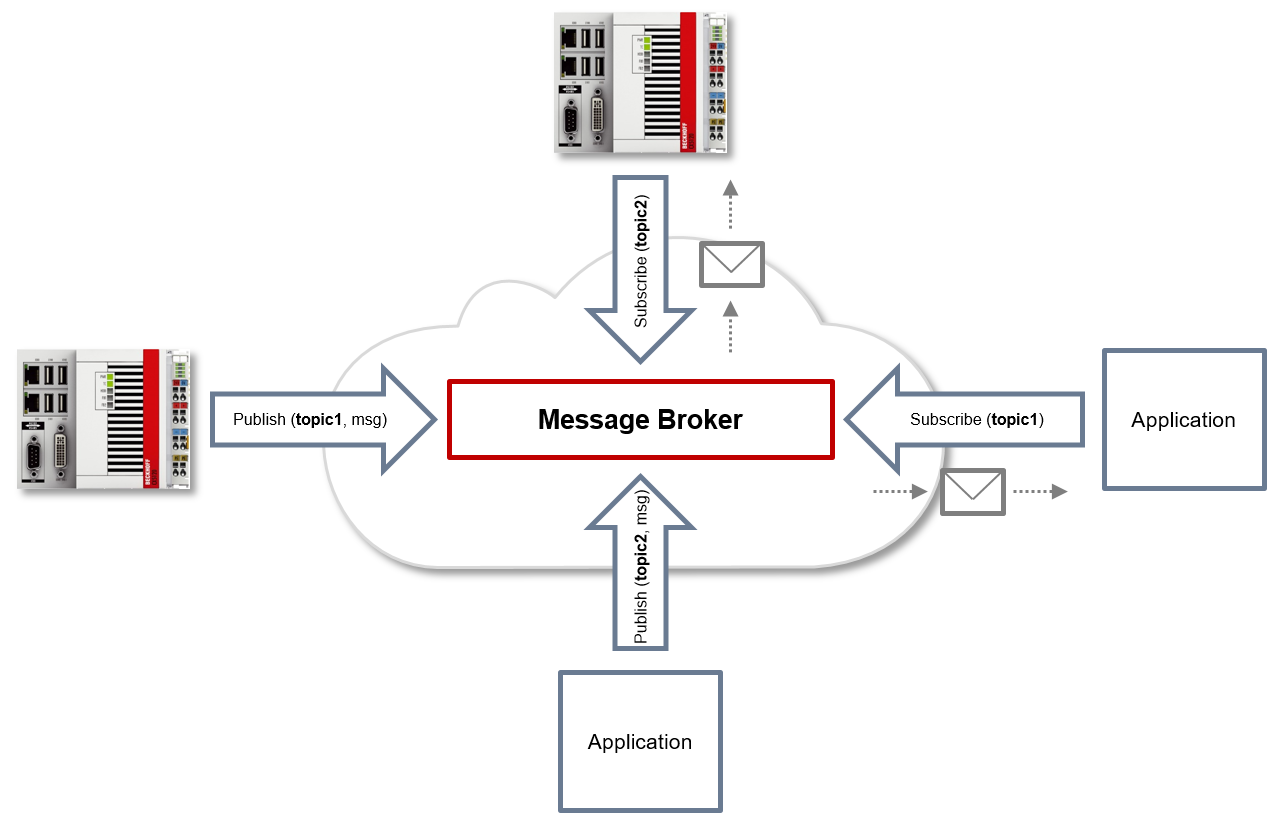MQTT basics
MQTT (Message Queueing Telemetry Transport) is a publisher/subscriber-based communication protocol which enables message-based transfer between applications. The message broker is a central component of this transfer type. It distributes messages between the individual applications or the sender and receiver of a message. The message broker decouples the sender and receiver, so that it is not necessary for the sender and receiver to know and exchange each other's address information. During sending and receiving, all communication devices contact the message broker, which handles the distribution of the messages.

ClientID
When establishing a connection with the message broker, the client transmits a ClientID, which is used to uniquely identify the client on the message broker. The MQTT communication driver from TwinCAT 3 automatically generates its own ClientID, which is based on the following naming scheme:
PlcProjectName-TcMqttClient%n
%n is an incremental counter for the number of the respective MQTT client instance. Each instance of the FB_IotMqttClient function block increments this counter. In most cases, using this ClientID format is sufficient. In special cases, e.g. depending on the message broker or also due to the own MQTT application, an application-specific ClientID must be assigned. This can be done via a corresponding input at the FB_IotMqttClient and FB_IotMqtt5Client function blocks.
If a unique ClientID is to be generated automatically at the start of the PLC project, the use of a GUID is recommended, which can be generated via the FB_CreateGuid function block from the Tc2_System library. The following sample code illustrates the use of this function block.
PROGRAM MAIN
VAR
fbGuid : FB_CreateGUID;
objGuid : GUID;
sGuid : STRING;
nState : UINT;
bStart : BOOL; // set to TRUE to start this sample
END_VAR
CASE nState OF
0 :
IF bStart THEN
bStart := FALSE;
nState := nState + 1;
END_IF
1 : // create GUID using FB_CreateGuid from Tc2_System library
fbGuid(bExecute := TRUE, pGuidBuffer := ADR(objGuid), nGuidBufferSize := SIZEOF(objGuid));
IF NOT fbGuid.bBusy THEN
fbGuid(bExecute := FALSE);
IF NOT fbGuid.bError THEN
nState := nState + 1;
ELSE
nState := 255; // go to error state
END_IF
END_IF
2: // GUID has been created, now convert to STRING
sGuid := GUID_TO_STRING(objGuid);
nState := nState + 1;
3: // done
255: // error state
END_CASEAfter execution of this State Machine, the variable sGuid contains the generated GUID as STRING. This can then be used at the FB_IotMqttClient and FB_IotMqtt5Client function blocks as ClientID.
Payload
The content of an MQTT message is referred to as payload. Data of any type can be transferred, e.g. text, individual numerical values or a whole information structure.
 | Message payload formatting Note that the data type and the formatting of the content must be known to the sender and receiver side, particularly when binary information (alignment) or strings (with or without zero termination) are sent. |
Topics
If a message broker is used that is based on the MQTT protocol, sending (publish mode) and subscribing (subscribe mode) of messages is organized with the aid of so-called topics. The message broker filters incoming messages based on these topics for each connected client. A topic may consist of several levels; the individual levels are separated by “/”.
Example: Campus / Building1 / Floor2 / Room3 / Temperature
When a publisher sends a message, it always specifies for which topic it is intended. A subscriber indicates which topic it is interested in. The message broker forwards the message accordingly.

Communication example 1 from the diagram above:
- An application subscribes to “topic1”.
- A controller publishes a message to “topic1”.
- The message broker forwards the message to the application accordingly.
Communication example 2 from the diagram above:
- A controller subscribes to “topic2”.
- An application publishes a message to “topic2”.
- The message broker forwards the message to the controller accordingly.
Wildcards
It is possible to use wildcards in conjunction with topics. A wildcard is used to represent part of the topic. In this case a subscriber may receive messages from several topics. A distinction is made between two types of wildcards:
- Single-level wildcards
- Multi-level wildcards
Example for single-level wildcard:
The + symbol describes a single-level wildcard. If it is used by the subscriber as described below, for example, corresponding messages to the topics are either received by the subscriber or not.
- The receiver subscribes to Campus/Building1/Floor2/+/Temperature
- The publisher sends to Campus/Building1/Floor2/Room1/Temperature - OK
- The publisher sends to Campus/Building1/Floor2/Room2/Temperature - OK
- The publisher sends to Campus/Building42/Floor1/Room1/Temperature - NOK
- The publisher sends to Campus/Building1/Floor2/Room1/Fridge/Temperature - NOK
Example for multi-level wildcard:
The # symbol describes a multi-level wildcard. If it is used by the subscriber as described below, for example, corresponding messages to the topics are either received by the subscriber or not. The # symbol must always be the last symbol in a topic string.
- The receiver subscribes to Campus/Building1/Floor2/#
- The publisher sends to Campus/Building1/Floor2/Room1/Temperature - OK
- The publisher sends to Campus/Building1/Floor2/Room2/Temperature - OK
- The publisher sends to Campus/Building42/Floor1/Room1/Temperature - NOK
- The publisher sends to Campus/Building1/Floor2/Room1/Fridge/Temperature - OK
- The publisher sends to Campus/Building1/Floor2/Room1/Humidity - OK
QoS (Quality of Service)
QoS is an arrangement between the sender and receiver of a message with regard to guaranteeing of the message transfer. MQTT features three different levels:
- 0 – not more than once
- 1 – at least once
- 2 – exactly once
Both types of communication (publish/subscribe) with the message broker must be taken into account and considered separately. The QoS level that a client uses for publishing a message is set by the respective client. When the broker forwards the message to client that has subscribed to the topic, the subscriber uses the QoS level that was specified when the subscription was established. This means that a QoS level that may have been specified as 2 by the publisher can be “overwritten” with 0 by the subscriber.
QoS-Level 0
At this QoS level the receiver does not acknowledge receipt. The message is not sent a second time.

QoS-Level 1
At this QoS level the system guarantees that the message arrives at the receiver at least once, although the message may arrive more than once. The sender stores the message internally until it has received an acknowledgement from the receiver in the form of a PUBACK message. If the PUBACK message fails to arrive within a certain time, the message is resent.

QoS-Level 2
At this QoS level the system guarantees that the message arrives at the receiver no more than once. On the MQTT side this is realized through a handshake mechanism. QoS level 2 is the safest level (from a message transfer perspective), but also the slowest. When a receiver receives a message with QoS level 2, it acknowledges the message with a PUBREC. The sender of the message remembers it internally until it has received a PUBCOMP. This additional handshake (compared with QoS 1) is important for avoiding duplicate transfer of the message. Once the sender of the message receives a PUBREC, it can discard the initial publish information, since it knows that the message was received once by the receiver. In other words, it remembers the PUBREC internally and sends a PUBREL. Once the receiver has received a PUBREL, it can discard the previously remembered states and respond with a PUBCOMP, and vice versa. Whenever a package is lost, the respective communication device is responsible for resending the last message after a certain time.

The LastWill is a message sent by the broker to all clients subscribed to the matching topic in the event of an abnormal connection failure. If the MQTT client in the PLC loses the connection to the broker and a LastWill was stored when the connection was established, this LastWill is communicated by the broker without the client having to do it.
In the event of a planned disconnect, the LastWill is not necessarily transmitted according to the specification. From the PLC programmer's point of view, he can decide whether he wants to publish the LastWill before calling the disconnect. To this end, the LastWill message is published again on the LastWill topic. This is necessary because the broker would not publish the LastWill message due to the regular disconnection.
In the event of a TwinCAT context change and a resulting restart of the MQTT communication, the IoT driver sends the previously specified LastWill to the broker, because at this point, doing this from the PLC is not an option. If no LastWill was defined when the connection was established, no message will be transmitted before the disconnect.
Safety
When a connection to the message broker is established, security mechanisms such as TLS can be used to encrypt the communication connection or to execute authentication between client and message broker.
Sources
For further and more detailed information about MQTT, we recommend the following sites:
HiveMq Blog: http://www.hivemq.com/blog/mqtt-essentials/ (the main basis for this article)